by Raphael Soldi
This year was my first time attending the ACHEMA conference. This is my reflection on the experience. This text outlines:
- Why I attended and what I hoped to get out of it
- What I observed and learned while there
- What is my outlook going forward
WHY ATTEND
Having never gone, I jumped on Gijs’ suggestion to attend ACHEMA. I additionally set it a goal to present to our ChemXpro/Chemploy team something that I learned from it, hence this paper. Branded as the world’s largest process industry exhibition for chemical engineering, process technology and biotechnology, the conference hosted numerous exhibition halls and a packed lecture programme across 4 days. Specifically, I sought out one of the conference’s anchor themes: Fossil Free Production, both for my own interest and for the relevance to my current assignment through Chemploy. I went in wishing to come out:
- Educated on cutting-edge technologies and equipment with which I was unfamiliar,
- Informed about the current situation of sustainability and the industry’s pledges, and
- Optimistic that the climate crisis is reversible and inspired/motivated to help make it happen.
Upon arrival, I was truly awestruck at the immensity of Frankfurt’s Messe conference complex, where it was held. The 7 multi-level exhibition halls were categorized by processes and industry, such as mechanical, heat, instruments, academia and research, among others.
The halls were a hub to bear witness to a variety of equipment demonstrations and simulations, truly an engineer’s equivalent of a toy museum, and I was not disappointed (Figure 1).

Figure 1: Cross-sectional model of venturi orifice steam trap by EBE Engineering; one of many ‘toys’
I will not delve deeply into the variety of companies showcasing their technologies. Still, they were big and small, European and foreign, old and start-ups, etc., all aiming to differentiate themselves through both technical means (and ample food selection). But beware, not because something is displayed at a conference, it makes it a good technology; many of us spotted the leaky reactor.
One technology that caught my attention was a steam jet cooling system by GEA; a 1.8m tall working demo model set up at their booth (Figure 2). This process aims to integrate waste heat with cooling duty by using low‑pressure steam to power a chilled‑water circuit. Conventional chilling with the use of a refrigerant is an expensive process. GEA’s design cools water without the need of a dedicated compressor or refrigerant. The water chamber’s pressure is reduced to pressures below its boiling point, causing some of the water to begin boiling, which simultaneously lowers its temperature. The low pressure has been induced by a jet stream of (waste) steam via the venturi effect. The small portion of evaporated water is carried with the steam, which may then be easily condensed and reused in the warm water or steam circuit.

Figure 2: Steam jet cooling system by GEA (from their website; my picture of their model was terrible)
Neither jet vacuums nor evaporative cooling are novel concepts, however the integration of these with the aim of reducing heat waste output and fresh energy input is commendable. Despite the specificity of the application, I can appreciate the systems thinking used to find a use for a ubiquitous plant waste steam. Indeed, a main theme across many of the companies in attendance was energy reduction, recycling, and decarbonization.
OBSERVATIONS
The Plastic Waste Crisis
Most lectures I attended focused on decoupling fossil fuels and the circular economy. In the context of process engineering, the challenges to circularity extend beyond just the technical and include logistical, administrative and – fundamentally – financial limitations. The magnitude of these challenges is reflected in statistics:
Take plastics, for instance, where new production is still derived overwhelmingly from virgin fossil fuels (Figure 3), in large part because the price of virgin plastic is dramatically lower than recycled material (Figure 4) as it is directly influenced by fossil fuel prices, as presented by a representative from Utrecht University. Plastic pricing entirely ignores the external costs it poses to society, estimated at an additional 800‑1400 $USD per tonne (Figure 5).

Figure 3: Breakdown of worldwide plastic production sources (2021)
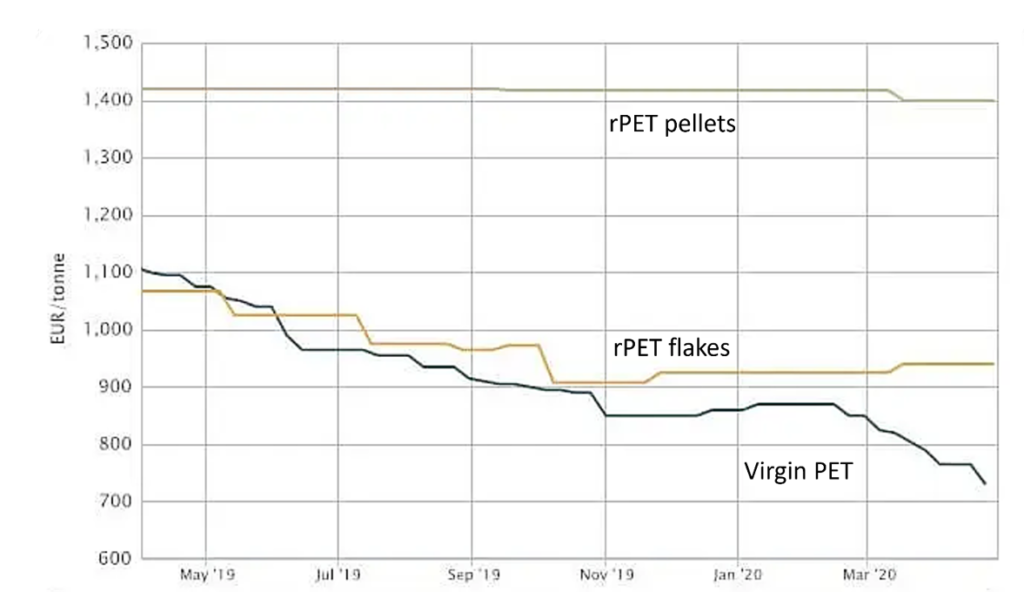
Figure 4: Price of virgin and recycled polyethylene terephthalate (PET), the most recycled type of plastic; from ICIS (2020)
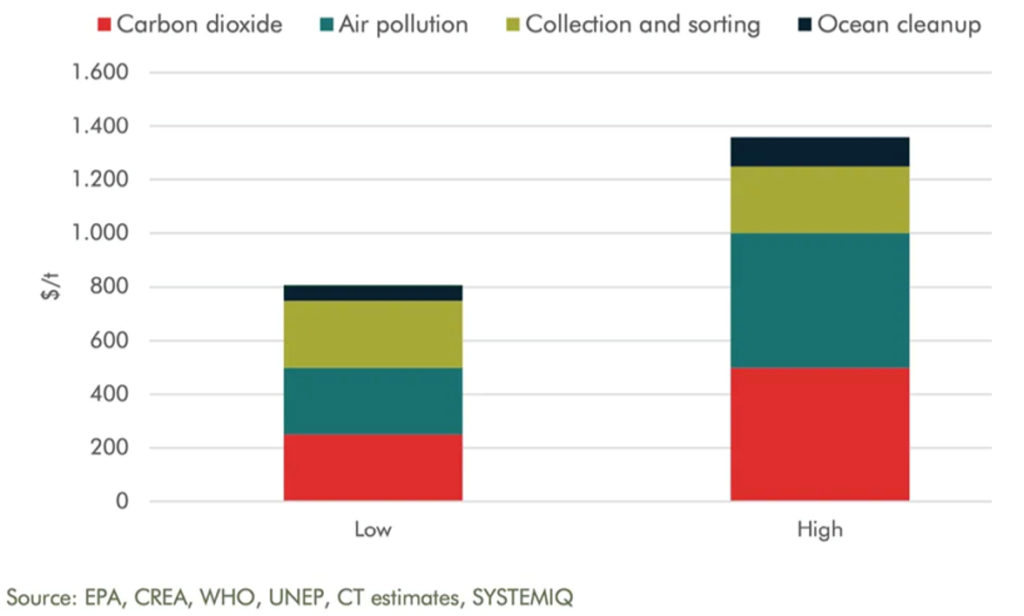
Figure 5: Plastic externalities per tonne (USD)
Recycling is expensive because much effort goes into making a small amount of feedstock. Figure 6 offers a simplified diagram of the recycling loop. Recycling begins with feedstock in the form of waste, itself not entirely pre‑sorted due to low consumer discipline. EU waste processing associations estimate roughly 40‑60% of all bins and bags contain misthrows (i.e., items in the incorrect bin). The collected waste must then be sorted via largely automated processes by material, size, and weight. The major challenges in sorting include different materials glued together (such as yoghurt cups and their lids), different colours which make it different for machines to recognize, and multilayer packaging (consisting of up to 15 different layered materials), which cannot be separated. Unfortunately, it is incineration and not recycling that is presently the EU’s primary method of plastic waste disposal (Figure 7). Incineration is generally used as a means for power generation and is often referred to by the less aggressive‑sounding names ‘waste‑to‑energy’ or ‘energy recovery.’
Because of the EU’s shortage of real estate and hygienic reasons, landfilling is not the preferred option for waste disposal despite offering some benefits in capturing carbon for longer periods of time than incineration. Incineration and landfilling account for 42% and 23% of plastic waste processing’s first pass.

Figure 6: Recycled plastics process loop (simplified); refer to Figure 8 for (*)
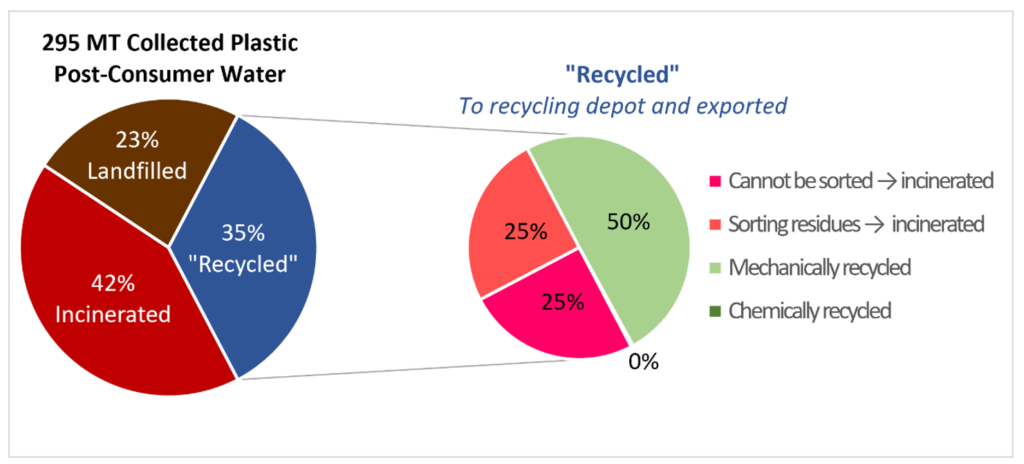
Figure 7: Consumer plastic waste processing in EU with “Recycled” category broken down (2021)
The remainder 35% of all collected post‑consumer waste plastics is termed ‘recycled’, meaning that it gets delivered to recycling depots in the EU. This figure includes all plastic waste also being exported, where it is well known to not always be neither recycled nor sanitarily disposed. At the recycling, depot material is sorted even further because conventional recycling processes require very specific types of feedstocks in order to produce consistent outputs. Roughly 50% of the delivered plastic actually gets mechanically recycled. About 25% of the material is mixed plastic waste that cannot be separated and is incinerated, while another 25% consists of sorting residues. Just about 0.2% of plastics are presently chemically recycled.
Plastic Recycling Technologies
Recycling technology can be divided into 2 broad categories: mechanical and chemical (Figure 8).
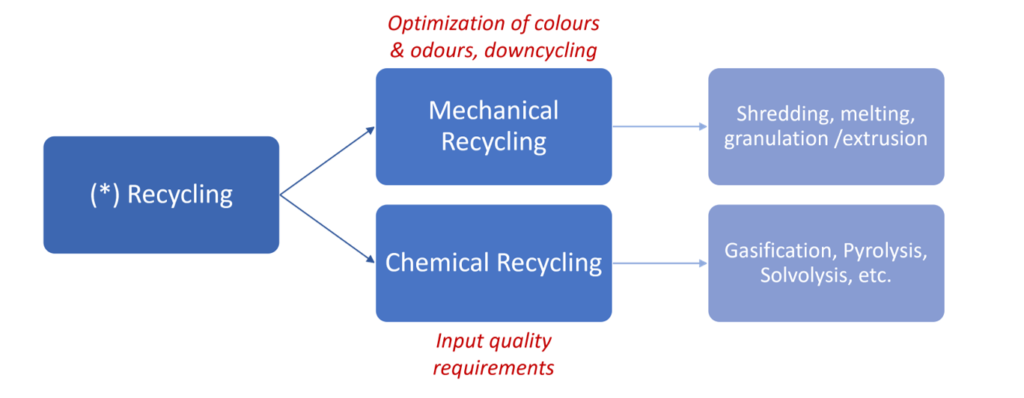
Figure 8: Two general families of recycling technologies, with challenges in red; refer to Figure 6 for (*)
Mechanical (conventional) recycling preserves the molecular structure of the material being fed, and there are many well established processes. It mechanically crushes the plastic and remelts it into granulate, which is then used to make new products (e.g., PET (Polyethylene Terephthalate) as water bottles and plastic trays, HDPE (High Density Polyethylene) as milk cartoons and shampoo bottles, or PP (Polypropylene) as margarine tubs and ready-meal trays). Mechanical recycling has the downside of producing plastics of degraded quality than was input (downcycle); this means quality downgrades with each recycling cycle until they become end‑of‑life (EoL) plastics.
In contrast, chemical recycling splits polymer chains into smaller molecules to produce a hydrocarbon oil and/or gas, a more fundamental chemical building block. This new feedstock is not only more versatile in how it can be used, but using it as the precursor to final plastic products provides them with virgin‑like quality. However, chemical recycling lacks large‑scale units to prove the technology, and current technologies are limited by the requirement of streamlined feedstock. This can be particularly challenging when the raw material is wasted. Figure 9 classifies many plastic recycling technologies by their basic working principles and their products, with chemical recycling encompassing many of the technologies shown, namely those which produce monomers, naphtha, or syngas. Table 1 summarizes the key pros and cons of the two different recycling categories.
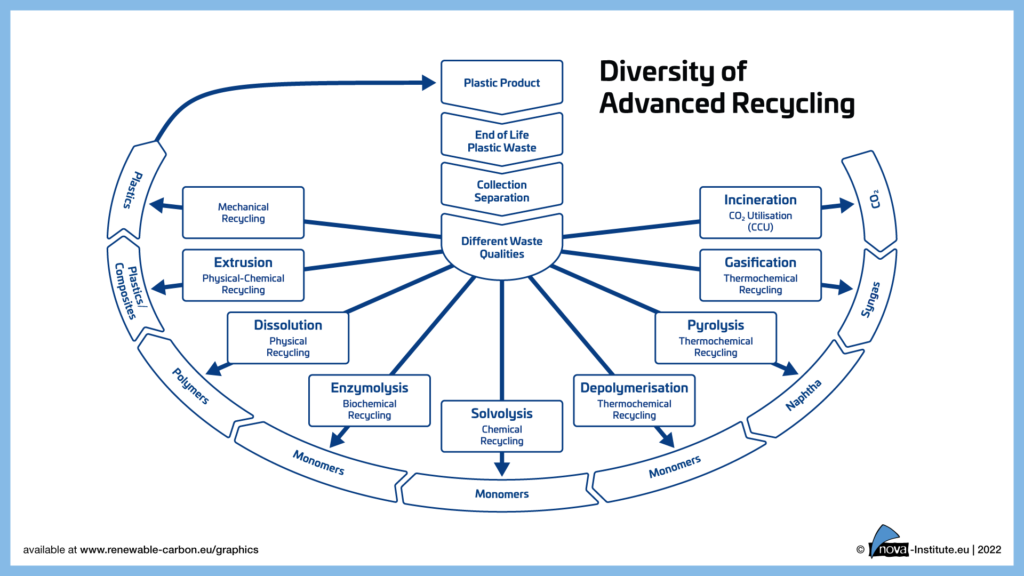
Figure 9: Classification of many plastic recycling techs. by their basic working principles and their products; from nova‑Institute
Table 1: Differences amongst mechanical and chemical & physical recycling; from nova-Institute
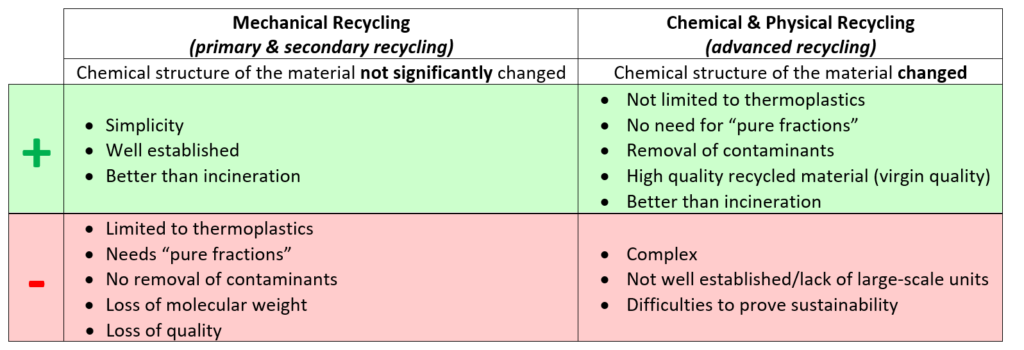
Given its promising advantages, chemical recycling must be recognized as an integral means to our recycling aspirations. We should be equally promoting and financially supporting both mechanical and chemical processes.
Many companies are embracing the circularity of plastics and adopting multiple recycling methods in parallel, such as Borealis. They aims to identify which technologies scale and may be useful under which circumstance, and how to combine and sequence them to achieve the best possible outcome. Their approach begins at the conception of plastics: minimize the use of resources and maximize their lifetime value, maximize reusability, and design them to be easily collected, sorted, and recycled. They also incorporate bio‑feedstocks to supplement their production of polyolefins.
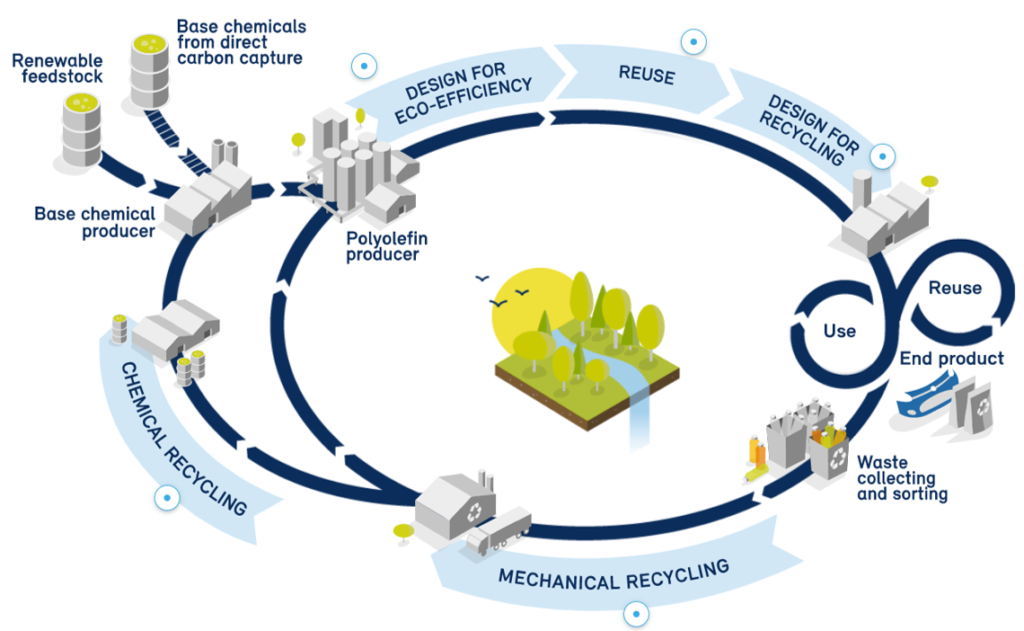
Figure 10: Borealis’ circular way, incorporating Borcycle™ M (mechanical) and Borcycle™ C (chemical) recycling technologies
Service providers, such as YNCORIS, aim to create a roadmap towards climate‑neutrality, highlighting the importance of collaborating across all parts of the value‑chain, governments, and stakeholders. They provided 6 points worth evaluating when developing innovative solutions for circularity:
- Do standards exist to support?
- Are NGOs supportive
- How does the system need to change to support?
- Are key business collaborations possible
- Are trade associations aligned?
- Does policy/regulation allow this?
Meanwhile, consultant Carbon Minds offers chemical producers a bottom‑up model to optimize sustainable technology selection and integration based on site‑level utilities, feedstock availability, economical and environmental parameters.
A resonating and recurring message from many of the companies presenting was that we must not get hung up trying to identify a fault‑free technology or the absolutely best‑fitted process for a specific set of conditions involving a complex value chain. Despite there being standards for conducting Life Cycle Assessments (ISO 14040/14044), it is still possible to get very different results depending on where the LCA boundaries are drawn. The results are sensitive to assumptions on location, energy mix, and recyclate quality.
There is no silver bullet to the climate crisis, and there is no one‑size‑fits‑all solution to recycling plastics. Leaders and engineers alike should evaluate the main resources and limitations (electricity, real estate, existing infrastructure, economic means, existing practices, among others) and proceed with a technology; imperfect action is better than perfect inaction. There is a sincere worry that as a society we are responding too slowly in trying to find a solution without any negative side effects.
European Progress
In Europe, there has been some progress made in reducing the amount of plastic produced, decreasing by an average rate of 6% per year since a peak in 2017 (Figure 11), although the same cannot be said about the world‑at‑large. In Europe, nearly 40% of all plastic is for packaging (commercial and industrial) and another 20% is for building and construction. These should be the target reduction areas in order to achieve the greatest impact. With market demand (consumers and brand owners) pulling on low-cost products, it rests with manufacturers to incorporate recycled content into their processes.
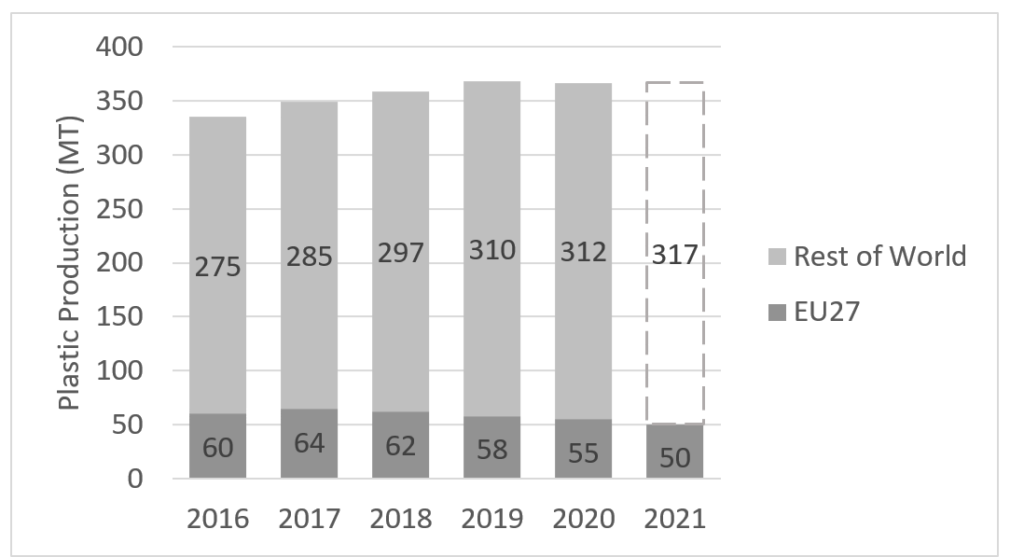
Figure 11: Annual EU & worldwide plastic production (2016-2021 estimate); from Plastics Europe
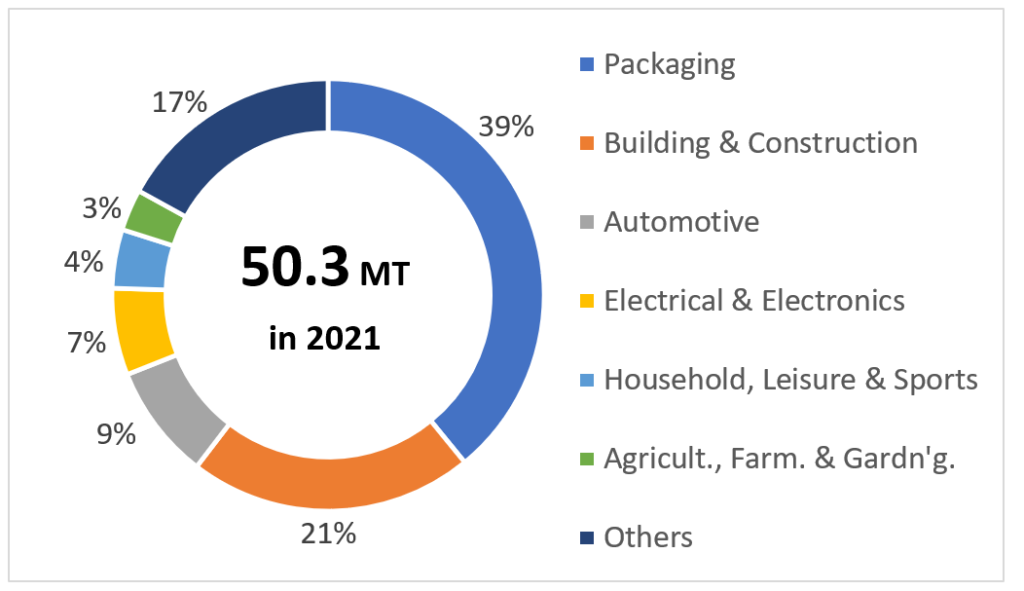
Figure 12: Breakdown of EU27 plastic production (2021); from Plastics Europe
A member of the European Parliament presented an overview of existing legislation around plastics. I was surprised by the lack of standards on recyclate quality and decontamination but also by the MEP’s awareness of greenwashing strategies commonly abused by the industry. Included amongst Parliament’s plans is investing in the development of chemicals that are safe and sustainable throughout their lifecycle, simplifying authorization processes with fewer procedures, and updating guidelines and standards. Most important to me was the presentation on existing and expected new regulations mandating recycled content requirements in plastics to leverage supply‑side recycling. Green premiums can only be expected to increase as brand owners increasingly require recyclates as part of their sustainability strategy, and feedstock sourcing remains difficult. With oil & gas companies and their shareholders earning record windfall profits as a result of the energy crisis of 2022, it is difficult for me to take their pledges seriously as they show on their websites that “Achieving Net Zero” and “Respect Nature” is on the same level as “Shareholder Value”. The policy is a key driver for waste management and the plastic industries, and subsidies or fees will be required to balance out the rising green premiums.
MY OUTLOOK
ACHEMA provided a holistic opportunity to see advances in the chemical process. I think the exhibition halls are well suited for wandering in amazement (as me) or for someone seeking a supplier or targeted advice/contacts on a specific need. The parallel lectures provide a wide sample of topics and multiple chances to hear from great minds in the industry. I think it serves one well to explore a diverse group of topics, and perhaps try attend a longer streamlined themed session. Subsequently, one can seek out more focused conferences designed for a narrower target audience and sub‑industry, such as the Advanced Recycling Conference, which I got to attend a few months later.
Both mechanical and chemical recycling have their strengths and weaknesses, and thus complimentary combination of both methods is needed to optimize plastics recycling. Mechanical recycling is more mature and widespread, and can be expected to gain more advantages with better design‑for‑recycling approaches, government regulation on manufacturing processes, and financial incentives for increased recyclate content. Chemical recycling on the other hand, while still underdeveloped, provides a pathway for closing the plastic loop by recycling those materials which would typically be waste (i.e. incinerated) at significant expense to the climate. Multiple LCAs reiterated the message: virtually all of the technologies are better than incineration. We must not expect nor depend solely on one type of technology to achieve the circular plastics economy.
While solutions depend on the local resources and limitations, we must focus on acting promptly. The coronavirus pandemic highlighted the enormous effort required to have any noticeable reduction in carbon emissions. Yet even that amounted to only a 6% reduction in 2020, with resources continuing to decrease and climate change charging on. We need regulation, and we need substantial progress; it does not have to be perfect, but it has to be now. To quote the science vlogger Hank Green, “Solving problems creates new problems. The last hundred years of remarkable increases in quality of life – and increases in the value we place on human life – would not have been possible without coal, oil, and gas. Those fuels created a huge number of problems, some of which we solved, and some of which are going to require us to stop using them in order to solve. Global warming is not a problem that was created by evil; it is a problem that was created by people solving problems. The world is messy and we need to stop thinking that we can survive in it without doing any harm. We need to find ways to mitigate the harm and solve the problems, but we also need to understand that the solutions to those problems will create more problems.”
A big thank you to Chemploy for the opportunity to partake in this conference, and to Mariëlle for all the coordinating! Thank you to the rest of the team that attended; I think we had some great socializing and networking even amongst ourselves, who may not always interact frequently.

